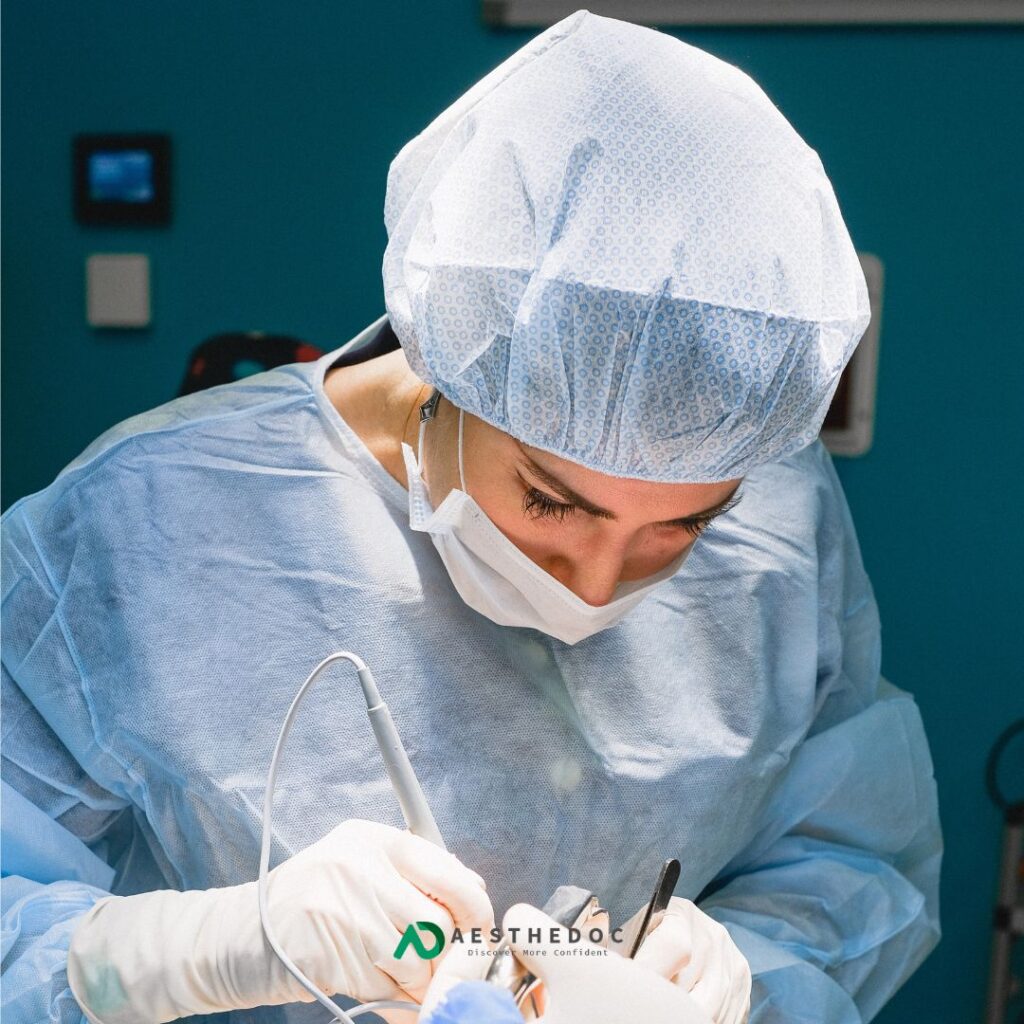Vaginoplasty
Vaginoplasty Surgery Cost in UK, Hymen Repair Aesthedoc

This article will provide you with information on vaginoplasty surgery cost in UK, a technique intended to improve women’s intimate health. Recognizing the normal changes that take place in the vagina throughout time is important since discussions about sexual and intimate aspects of life can continue to be sensitive for many people and can make women uncomfortable.
A brief description of vaginal construction in UK, reveals it to be a muscular canal made up of numerous layers of tissue, which are responsible for the lining’s flexibility and softness. The vagina, located in the pelvic area right behind the bladder, has walls that can stretch remarkably, as they do during childbirth, while yet maintaining a remarkable level of strength and flexibility.
But as time goes on, the vaginal muscles may lose some of their strength and suppleness, resulting in looser walls and thinner vaginal tissue. As a result, women may experience problems including pain, dryness, itching, and discomfort while engaging in sexual activity, as well as possible changes in the visual look of the vagina.
What is Vaginoplasty OR Vaginal Reconstruction?
Simply put, vaginoplasty is a surgical procedure that aims to improve the function of the vaginal walls and muscles in order to increase sexual experiences. This treatment is also successful in treating urine incontinence, a problem that many women encounter, especially after childbirth or as they get older.
Depending on the exact issue, this surgical technique may be referred to as vaginal tightening, genitoplasty, vagina reconstruction, vaginal rejuvenation surgery, or plastic surgery for vaginal rejuvenation. All of these terms apply to the same vaginal procedure.
Notably, hymen restoration surgery in uk, can also refer to sex-reassignment procedures, including creating a vagina. Only certified vaginoplasty surgeons in abroad, often specialized gynecologists with experience in female vaginal treatments, should conduct this type of plastic surgery.
Vaginal Tightening: Main Reason for Vaginoplasty
Women who have slack or loose vagina, impaired vaginal sensitivity, or who want vaginal tightening can benefit from cosmetic vaginoplasty. Urinary incontinence, dryness, pain, and other problems brought on by frail tissues and muscles can all be treated surgically.
It is important to consider the procedure’s viability, especially given that vaginal tightening surgery in uk frequently has affordable costs. In some cases, the NHS might even foot the bill. The Vaginoplasty Surgery Cost in UK is very variable but not know about its results.
Candidates for Vaginoplasty
Hymen repair surgery is suitable for females who:
- Desire to address various hymen-related concerns.
- Seek to alleviate worries about hymen perforations or imperfections.
- Wish to enhance sexual experience post-childbirth.
- Require repair due to accidental hymen injuries.
- Have concerns about hymen size and shape.
- Need cosmetic or functional restoration following trauma.
- Are motivated by personal or cultural beliefs.
What are the possible complications of Hymenoplasty?
Following surgery, the area may experience any of the following side effects -Localised swelling or inflammation.
- Spot bleeding every now and then for a few days.
- Stitches-related itching.
- Possible anesthesia-related allergic responses.
- Possibilities of feeling queasy or throwing up.
- Blood clots forming in the treated area.
- A brief numbness in the area.
- Noticing the darkening of the hymen.
- The potential for nearby illnesses to spread.
Preparation for Vaginoplasty
Patients are consistently provided with specific instructions to adhere to before undergoing vaginoplasty.
Common directives for patients encompass:
- Cessation of Smoking: Patients are required to cease smoking for a minimum of 2 months before the scheduled surgery. However, discontinuing smoking even earlier than this timeframe is strongly advised.
- Medical Evaluation and Tests: Attend a comprehensive physical examination and undergo essential medical tests as designated by the surgeon.
- Hydration: Maintain a daily intake of at least 2 liters of water. The surgeon may also recommend a specialized bowel-cleansing solution to be consumed prior to the surgery.
- Nutrient-Rich Diet: Follow a well-balanced diet that is replete with essential nutrients.
- Liquid Diet Consideration: If advised, adhere to a specialized liquid diet in the days leading up to the surgery.
- Avoid Nail Polish: Refrain from applying nail polish during the period surrounding the surgery.
Short Detail: Procedure
Vaginal surgery is performed while the patient is unconscious, guaranteeing that an anesthesiologist is present the entire time to watch over the patient. This results in a deep slumber and total pain relief for the sufferer. Local anesthetic may be sufficient on occasion, usually in simple cases or for small changes. The entire procedure usually takes at least an hour, and patients frequently stay in the hospital the night after surgery to recover.
After inducing anesthesia, the surgeon waits for the patient to fall asleep before starting to make the preplanned changes to the vaginal area. Typically, this involves toning the muscles of the vagina, removing extra skin and tissues, and reducing extra vaginal lining.
The resulting scars are contained inside the vaginal area, and the sutures used are absorbable, thus removal is not required. Sex reassignment surgeries may involve more complicated procedures that could take several hours to complete and involve additional anatomical considerations and post-operative dangers.
Recovery Time After Vaginoplasty
The healing phase following plastic surgery is crucial to the process of change the operation started. This step has a significant impact on the procedure’s overall results, healing process, and final results. Patients should therefore adequately prepare for this time period. The recuperation time following a vaginoplasty lasts, on average, six weeks. Naturally, depending on the specific method and approach used during the vaginoplasty as well as the person’s individual potential for healing and recovery, this period may change.
Vaginoplasty Surgery Cost in UK
Numerous private hospitals and plastic surgery practices in the UK offer the option of undergoing vaginoplasty. It’s significant to remember that there is no set Vaginal reshaping cost in the UK; instead, costs might range from 5,500 GBP to more than 20,000 GBP.
A vaginal tightening procedure normally costs between 6,000 and 6,500 GBP in the UK, whilst vaginal rejuvenation in London costs around 5,000 GBP. The most expensive procedures are those for sex reassignment, which are typically charged on an individual basis and typically cost more than aesthetic vaginoplasty.
Why You Want To Chose Us?
At the Hymen Reconstruction Surgery Website, we offer a welcoming and inclusive atmosphere, featuring board-certified cosmetic surgeons dedicated to safety and favorable outcomes. Our commitment revolves around delivering the utmost quality care to our patients. Through our cost-effective hymenoplasty options in UK, we aim to assist our patients in restoring confidence and a sense of youthfulness.

Vaginal Tightening
Vaginoplasty in Rawalpindi

Over the past few years, vaginoplasty in Rawalpindi has become one of the most requested cosmetic gynecology procedures for women who want to restore their intimate health, improve vaginal tightness, enhance sexual satisfaction, and reclaim confidence after childbirth, aging, or physical changes.
Unlike traditional surgical treatments, modern vaginal tightening surgery is safer, more precise, and offers natural results with minimal downtime. Women of all ages—from young mothers to perimenopausal patients—now consider the procedure to improve:
- Vaginal laxity
- Personal confidence
- Intimate relationship satisfaction
- Urinary control
- Pelvic floor health
- Overall quality of life
If you’ve been searching for “best vaginoplasty in Rawalpindi”, “vaginal tightening surgery cost Rawalpindi”, or “cosmetic gynecologist Rawalpindi”, this in-depth guide will help you understand everything clearly—based on medical expertise, evidence, and real patient experience.
1. What Is Vaginoplasty?
A medically verified explanation for patients
Vaginoplasty is a surgical vaginal tightening procedure designed to reconstruct and tighten the vaginal canal by bringing stretched vaginal tissues and pelvic floor muscles back to their original, stronger position.
It is performed by a qualified gynecologist or cosmetic gynecology surgeon, and its goal is to improve:
- Vaginal tightness
- Muscle tone
- Structural strength
- Sexual function
- Confidence and comfort
Vaginoplasty is NOT just a cosmetic procedure — it is also a functional restoration surgery.
2. Why Do Women Need Vaginoplasty?
Top medical reasons women consider vaginal tightening surgery in Rawalpindi
Many women experience changes in vaginal structure due to:
a) Childbirth
Vaginal delivery stretches tissues, ligaments, and muscles, leading to:
- Vaginal looseness
- Reduced sensation
- Poor muscle control
- Sexual dissatisfaction
b) Aging & Hormonal Changes
Low estrogen levels cause thinning of tissues and decreased elasticity.
c) Menopause
Leads to vaginal atrophy, dryness, and laxity.
d) Genetic or Structural Weakness
e) Weight fluctuations
f) Pelvic floor muscle weakness
g) Excessive stretching during intercourse over years
Vaginoplasty corrects these physical changes and restores the vaginal canal to a tighter, younger, and more functional state.
3. Difference Between Vaginoplasty & Non-Surgical Vaginal Tightening
Many women confuse surgical vaginoplasty with non-surgical laser tightening. Here is a clear comparison:
| Feature | Vaginoplasty (Surgical) | Laser / RF Tightening (Non-surgical) |
|---|---|---|
| Tightening Level | 60–80% tightening | 20–35% tightening |
| Results | Permanent | Temporary (12 months) |
| Downtime | 1–2 weeks | No downtime |
| Ideal For | Moderate to severe laxity | Mild laxity |
| Sensation Improvement | High | Mild to moderate |
| Pelvic Floor Support | Strong improvement | Limited |
If your laxity is severe, only surgical vaginoplasty gives permanent and effective results.
4. Conditions That Vaginoplasty Can Treat
Vaginoplasty in Rawalpindi is commonly recommended for:
- Severely loose vagina
- Sexual dissatisfaction due to laxity
- Loss of friction during intercourse
- Pelvic floor weakness
- Urinary leakage (stress incontinence)
- Vaginal shape changes after childbirth
- Bulky or stretched vaginal opening
5. Benefits of Vaginal Tightening Surgery
Women choosing vaginoplasty in Rawalpindi report many benefits:
1. Restores Vaginal Tightness
Reconstructs tissues and reduces vaginal diameter.
2. Stronger Pelvic Floor
Improves muscle support and body stability.
3. Enhanced Intimate Satisfaction
Both partners feel increased friction and sensitivity.
4. Boosts Confidence & Femininity
Women feel rejuvenated, youthful, and confident.
5. Improves Urinary Control
Helpful in cases of stress urinary incontinence.
6. Long-Lasting Results
A one-time procedure with permanent improvement.
6. How the Vaginoplasty Procedure Works
Vaginoplasty is performed under local anesthesia with sedation or general anesthesia, depending on the patient’s condition.
Step-by-Step:
1. Marking & Evaluation
The surgeon identifies loose tissues and stretched muscles.
2. Incision Inside the Vagina
A small incision is made inside the vaginal canal (no visible external scars).
3. Muscle Repair
The stretched pelvic floor muscles are pulled together and tightened.
4. Tissue Removal
Excess mucosal tissue is trimmed.
5. Reconstructive Suturing
Dissolvable stitches are placed to create a tighter and firmer canal.
Duration: 45–75 minutes
Hospital Stay: Same-day discharge
7. Is Vaginoplasty Painful?
Most patients report minimal discomfort because:
- Local anesthesia is used
- Sedation reduces awareness
- Dissolvable stitches avoid irritation
Post-procedure, mild soreness lasts 3–5 days and is easily manageable with medication.
8. Recovery After Vaginoplasty
Downtime: 7–14 days
Full Healing: 6–8 weeks
Post-Surgery Guidelines:
- No intercourse for 6–8 weeks
- Avoid lifting heavy weights
- Maintain hygiene
- Use prescribed ointments
- Attend follow-ups
9. Who Is the Best Candidate for Vaginal Tightening Surgery?
You may benefit from vaginoplasty in Rawalpindi if you have:
- Loose vaginal canal
- Loss of sensation
- Difficulty holding urine
- Vaginal widening after childbirth
- Discomfort during intercourse
- Feeling of “air passage” or looseness
Women who completed childbearing often get the best long-term results.
10. Risks & Safety Considerations
Vaginoplasty is considered safe when performed by a qualified and trained cosmetic gynecology surgeon.
Possible temporary side effects:
- Mild pain
- Swelling
- Spotting
- Tightness sensation
Serious complications are rare when done by an experienced surgeon.
11. Vaginoplasty Results – What to Expect
Most women notice:
- Better tightness
- More pleasurable intercourse
- Enhanced relationship bonding
- Improved confidence
- Stronger pelvic floor
- Better urinary control
Results continue to improve for 3–4 months as tissues heal fully.
12. Cost of Vaginoplasty in Rawalpindi (2025 Updated)
The cost varies based on surgeon expertise, location, and surgical technique.
However, the general price range for vaginoplasty in Rawalpindi is:
PKR 120,000 – PKR 250,000
Cost includes:
- Surgeon fee
- Anesthesia
- Operation theatre charges
- Follow-up visits
- Medication (in some clinics)
Some clinics may offer installment or package options.
13. Choosing the Best Cosmetic Gynecologist for Vaginoplasty in Rawalpindi
Selecting the right doctor is critical for safe and natural results.
You should look for:
✔ FCPS-qualified gynecologist
✔ Fellowship in aesthetic gynecology
✔ Experience in vaginal reconstructive surgeries
✔ Proven patient results
✔ Sterile, safe environment
This is why Aesthedoc Clinic Rawalpindi is one of the most trusted names for cosmetic gynecology procedures.
14. Why Women Trust Aesthedoc Clinic in Rawalpindi
Aesthedoc Clinic is known for:
- Personalized consultation
- Privacy-focused environment
- Advanced surgical technology
- High hygiene standards
- Holistic pre- and post-treatment care
- Experienced female gynecologist surgeon
Patients receive transparent guidance, realistic expectations, and compassionate care.
15. Meet the Surgeon: Dr. Naila Frukh (Aesthedoc Clinic)
Cosmetic Gynecologist Surgeon – Specialist in Vaginoplasty & Intimate Wellness
Dr. Naila Frukh is one of Rawalpindi’s leading female cosmetic gynecologists and vaginal reconstructive surgeons.
Her qualifications:
- MBBS – Nishtar Hospital (2015)
- WMO – Population Welfare Department (2016)
- FCPS – Obstetrics & Gynecology (2024)
- Fellowship in Aesthetic Gynecology – American Board (2023)
Her expertise combines clinical gynecology with modern cosmetic gynecology, giving patients safe, natural, and long-lasting results.
She specializes in:
- Vaginoplasty
- Vaginal Tightening Surgery
- Labiaplasty
- Hymenoplasty
- Laser Vaginal Rejuvenation
- Stress Urinary Incontinence Treatment
- Intimate Area Aesthetic Procedures
She is known for her compassionate approach, attention to detail, and commitment to patient privacy and comfort.
16. Frequently Asked Questions (FAQ)
These FAQs are optimized for Featured Snippets and Google AI Overview.
1. What is vaginoplasty?
A surgical procedure that tightens the vaginal canal by repairing muscles and removing excess tissue.
2. Is vaginoplasty painful?
No, because anesthesia is used. Mild soreness occurs for a few days.
3. How long does recovery take?
7–14 days for normal activities, 6–8 weeks for complete healing.
4. How long do results last?
Vaginoplasty provides long-term permanent tightening if childbirth is complete.
5. What is the cost of vaginoplasty in Rawalpindi?
PKR 120,000 to PKR 250,000 depending on complexity and surgeon expertise.
6. When can I resume intercourse?
After 6–8 weeks.
7. Does vaginoplasty also improve sexual pleasure?
Yes, the tightening increases friction, sensation, and satisfaction for both partners.
17. Final Words: Should You Consider Vaginoplasty in Rawalpindi?
If you feel a loss of vaginal tightness, discomfort during intimacy, or reduced sensation after childbirth or aging, vaginoplasty is one of the most effective, permanent, and medically safe solutions.
Thousands of women now choose vaginal tightening surgery to:
- Regain confidence
- Improve intimate satisfaction
- Rebuild pelvic muscle strength
- Restore femininity and comfort
If you’re considering the procedure, choose a clinic with qualified gynecologists and a trained cosmetic gynecology surgeon.
For Appointments & Expert Consultation
Book your consultation at Aesthedoc Clinic Rawalpindi with:
Dr. Naila Frukh
Cosmetic Gynecologist Surgeon
MBBS (Nishtar Hospital)
FCPS (Gynecology & Obstetrics)
Fellowship in Aesthetic Gynecology – American Board
Aesthedoc Clinic offers private, safe, and advanced surgical solutions for vaginal tightening and women’s intimate wellness.
Vaginal Tightening
Vaginal Tightening in Vehari

Many women experience vaginal laxity, or looseness, due to:
- Vaginal childbirth
- Aging and hormonal changes
- Pelvic floor weakness
- Trauma or accidents
Symptoms include:
- Vaginal looseness
- Reduced sexual satisfaction
- Mild urinary leakage
- Vaginal dryness
- Loss of confidence
For women in Vehari, non-surgical vaginal tightening offers safe, minimally invasive, and effective solutions to restore vaginal elasticity and sensation without the risks of traditional surgery.
Chapter 1: Understanding Vaginal Laxity
Vaginal laxity affects both physical and emotional well-being. It can cause:
- Loss of sexual satisfaction
- Emotional distress
- Mild urinary incontinence
Common Causes
- Childbirth: Vaginal tissue stretches significantly during delivery
- Aging & Menopause: Declining estrogen reduces collagen and elasticity
- Trauma or Surgery: Accidents or prior gynecological procedures
- Obesity & Weight Fluctuations: Extra strain on pelvic muscles
- Genetics: Some women naturally have less elastic connective tissue
Chapter 2: Benefits of Non-Surgical Vaginal Tightening
Non-surgical vaginal tightening treatments offer:
- No incisions or stitches
- Minimal discomfort and downtime
- Quick procedures (20–45 minutes)
- Natural, progressive improvement in vaginal tone
- Enhanced sexual satisfaction and intimate confidence
- Improvement in mild urinary incontinence
These treatments stimulate collagen and elastin production, improving vaginal elasticity naturally.
Chapter 3: Laser Vaginal Tightening Vehari
Laser vaginal tightening is a leading non-surgical procedure in Vehari.
How Laser Works
- A medical-grade laser is inserted into the vaginal canal
- Laser energy creates micro-thermal columns in the tissue
- Stimulates collagen and elastin regeneration
- Tightens vaginal walls
- Improves natural lubrication and sensation
Benefits
- Painless and minimally invasive
- Short procedure (15–20 minutes)
- Immediate subtle tightening
- Full results in 4–6 weeks
- Improves sexual satisfaction and vaginal moisture
Ideal Candidates
- Postpartum women with mild to moderate laxity
- Women experiencing dryness or discomfort
- Women seeking non-surgical vaginal rejuvenation
Chapter 4: HIFU Vaginal Tightening Vehari
HIFU (High-Intensity Focused Ultrasound) is a deeper tissue treatment.
How HIFU Works
- Ultrasound energy penetrates deep vaginal tissue and muscles
- Heat stimulates collagen contraction and regeneration
- Improves elasticity and tightness from inside out
Benefits
- Longer-lasting results than superficial treatments
- Non-invasive with no downtime
- Improves lubrication, sensation, and sexual pleasure
- Can reduce mild urinary incontinence
Treatment Plan
- Usually one session is sufficient
- Follow-up after 6–12 months may be recommended for maintenance
Chapter 5: Other Non-Surgical Options
- Radiofrequency (RF) Therapy: Stimulates collagen and tightens tissue
- Energy-Based Devices: Enhance vaginal tone and elasticity
- Pelvic Floor Exercises (Kegels): Complementary to device-based treatments
Ideal for women with mild vaginal laxity or those preferring completely non-invasive options.
Chapter 6: Comparing Laser, HIFU, and Other Methods
| Feature | Laser | HIFU | Other Non-Surgical Methods |
|---|---|---|---|
| Depth | Medium | Deep | Shallow–Medium |
| Best For | Mild-moderate laxity | Moderate-severe laxity | Mild laxity |
| Pain | Minimal | Minimal–Moderate | None |
| Downtime | None | None | None |
| Session Requirement | 1–3 | 1 | 2–4 |
| Result Duration | 6–18 months | Up to 2 years | 9–12 months |
Women in Vehari commonly choose laser for mild cases and HIFU for long-lasting, deeper tissue tightening.
Chapter 7: Who Can Benefit from Non-Surgical Vaginal Tightening?
- Postpartum women
- Women experiencing age-related laxity
- Mild urinary leakage
- Women seeking improved intimate confidence
- Those looking for safe, quick, non-invasive solutions
Chapter 8: Safety and Risks
Non-surgical vaginal tightening is highly safe when performed by a qualified cosmetic gynecologist.
Minor effects may include:
- Mild warmth or tingling during treatment
- Temporary swelling or sensitivity
- Rare irritation
No major complications occur with proper medical supervision.
Chapter 9: Recovery and Aftercare
- Normal daily activities can resume immediately
- Sexual activity usually resumes after 48–72 hours (as advised)
- Avoid hot baths, swimming, or tight clothing for 48 hours
- Maintain hygiene and hydration
Chapter 10: Expected Results
- Immediate subtle vaginal tightening
- Full results in 4–6 weeks
- Enhanced natural lubrication and sensation
- Long-lasting effects: Laser 12–18 months, HIFU up to 2 years
- Boosted confidence and intimacy
Chapter 11: Frequently Asked Questions (FAQ)
Q1: Does it hurt?
A: Mild warmth; mostly painless.
Q2: When are results visible?
A: Minor improvement immediately; full results in 4–6 weeks.
Q3: Safe after childbirth?
A: Yes, typically 3 months postpartum.
Q4: Can I breastfeed?
A: Yes, treatments are safe during lactation.
Q5: How long do results last?
A: Laser: 12–18 months; HIFU: up to 2 years.
Q6: Does it help dryness?
A: Yes, improves natural lubrication.
Q7: Can it reduce mild urinary leakage?
A: Yes, strengthens vaginal and pelvic tissues.
Chapter 12: Choosing the Right Clinic in Vehari
Look for:
- Board-certified cosmetic gynecologists
- FDA-approved or clinically validated devices
- Hygienic, private facility
- Personalized consultation and treatment plan
- Post-procedure follow-up
Avoid unqualified providers to prevent ineffective results or complications.
Chapter 13: Aesthedoc Clinic – Trusted in Vehari
Dr. Naila Frukh – Cosmetic Gynecologist Surgeon
- MBBS – Nishtar Hospital (2015)
- WMO – Population Welfare Department (2016)
- FCPS – Obstetrics & Gynecology (2024)
- Fellowship in Aesthetic Gynecology – American Board (2023)
Why Choose Aesthedoc Clinic?
- Expertise in laser and HIFU vaginal tightening
- Private and confidential care
- Advanced technology ensures safe, reliable results
- Personalized treatment plans
At Aesthedoc Clinic, your comfort, privacy, and confidence are our priority.
Chapter 14: Conclusion
For women in Vehari seeking:
- Non-Surgical Vaginal Tightening
- Laser Vaginal Tightening
- HIFU Vaginal Tightening
…these treatments are safe, effective, and fast, restoring vaginal tone, sensation, and confidence.
Consult Dr. Naila Frukh at Aesthedoc Clinic for a personalized treatment plan.
Vaginal Tightening
Vaginoplasty in Vehari

Many women experience vaginal laxity, or looseness, due to:
- Childbirth
- Aging and hormonal changes
- Pelvic floor weakness
- Trauma or prior surgery
Symptoms include:
- Reduced vaginal tightness
- Lower sexual satisfaction
- Mild urinary incontinence
- Vaginal dryness
- Reduced confidence
In Vehari, women increasingly turn to vaginoplasty and vaginal tightening surgery to regain intimate confidence and improve sexual and emotional well-being.
Chapter 1: What is Vaginoplasty?
Vaginoplasty is a surgical procedure that restores vaginal tightness. It involves:
- Tightening vaginal muscles
- Removing excess mucosal tissue
- Enhancing pelvic floor support
Medical Perspective
- Functional and cosmetic procedure
- Performed under local or general anesthesia
- Duration: 60–90 minutes
- Improves vaginal tone, sensation, and sexual satisfaction
Chapter 2: Causes of Vaginal Laxity
1. Post-Childbirth Changes
Vaginal tissue stretches during vaginal delivery, leading to:
- Vaginal looseness
- Reduced friction during intercourse
- Emotional distress
2. Aging and Hormonal Decline
Estrogen loss causes:
- Decreased collagen
- Reduced tissue elasticity
- Vaginal dryness
3. Trauma or Prior Surgery
- Pelvic injuries or gynecological procedures can weaken vaginal structure
4. Genetics
- Some women naturally have less elastic connective tissue
Chapter 3: Symptoms of Vaginal Laxity
- Vaginal looseness
- Decreased sexual satisfaction
- Mild urinary leakage
- Emotional and psychological impact
- Vaginal dryness
Women experiencing these symptoms may consider vaginal tightening surgery as a solution.
Chapter 4: Vaginoplasty Procedure – Step by Step
1. Consultation
- Detailed review of medical history
- Physical examination of vaginal tissues and pelvic muscles
- Discussion of expectations and procedure type
2. Anesthesia
- Local anesthesia with sedation
- General anesthesia optional
3. Surgical Technique
Steps:
- Marking areas of tissue laxity
- Removal of excess vaginal mucosa
- Tightening vaginal muscles (levator ani and perineal muscles)
- Optional perineoplasty for aesthetic enhancement
- Closure with absorbable sutures for natural appearance
Procedure Duration: 60–90 minutes
Chapter 5: Recovery After Vaginal Tightening Surgery
Immediate Recovery
- Mild swelling
- Light bleeding
- Minor discomfort
Timeline
- Week 1: Light walking and daily activities
- Week 2–3: Swelling and discomfort resolve
- Week 4–6: Internal healing completes
- Week 6–8: Sexual activity can safely resume
Postoperative Care
- Avoid sexual activity for 6–8 weeks
- Maintain hygiene
- Wear loose-fitting clothing
- Follow prescribed medications
Chapter 6: Benefits of Vaginoplasty
- Permanent vaginal tightening
- Improved sexual pleasure
- Restored confidence
- Corrects post-childbirth injuries
- Strengthens pelvic floor muscles
- Enhances overall quality of life
Chapter 7: Risks & Safety Considerations
Vaginoplasty is generally safe under a certified cosmetic gynecologist.
Potential minor risks:
- Temporary swelling or bruising
- Mild bleeding
- Rare infection
- Rare over-tightening or scarring
Tip: Avoid unqualified providers to prevent complications.
Chapter 8: Ideal Candidates
- Women with post-childbirth vaginal laxity
- Women with reduced sexual satisfaction
- Mild urinary incontinence
- Women seeking long-term results
- Women not planning pregnancy immediately
Chapter 9: Myths About Vaginal Tightening Surgery
Myth 1: Only cosmetic
Fact: Improves function and aesthetics
Myth 2: Affects fertility
Fact: Fertility remains unaffected
Myth 3: Painful recovery
Fact: Pain is mild and manageable
Myth 4: Looks unnatural
Fact: Skilled surgeons achieve natural appearance
Chapter 10: Cost of Vaginoplasty in Vehari
Factors influencing cost:
- Surgeon’s expertise
- Clinic facilities
- Complexity of vaginal laxity
- Advanced sutures and surgical techniques
Aesthedoc Clinic offers affordable, high-quality, and confidential vaginal tightening procedures.
Chapter 11: Choosing the Right Surgeon
Choose a surgeon who:
- Is board-certified in obstetrics, gynecology, and cosmetic gynecology
- Has experience in vaginoplasty and pelvic reconstruction
- Uses advanced techniques
- Provides confidential and patient-centered care
Chapter 12: Meet Dr. Naila Frukh
Dr. Naila Frukh – Cosmetic Gynecologist Surgeon at Aesthedoc Clinic
- MBBS – Nishtar Hospital (2015)
- WMO – Population Welfare Department (2016)
- FCPS – Obstetrics & Gynecology (2024)
- Fellowship in Aesthetic Gynecology – American Board (2023)
Why choose Dr. Naila?
- Expertise in vaginoplasty and vaginal tightening surgery
- Confidential care in a private setting
- Advanced surgical techniques
- Natural, reliable results
Chapter 13: Frequently Asked Questions (FAQ)
Q1: Is vaginoplasty painful?
A: Mild discomfort, anesthesia ensures pain-free procedure.
Q2: When can normal activity resume?
A: Light activity within days; sexual activity after 6–8 weeks.
Q3: Are results permanent?
A: Yes, vaginal tightness is restored; future childbirth may stretch tissue.
Q4: Is it safe?
A: Yes, under certified cosmetic gynecologist supervision.
Q5: How long does it take?
A: 60–90 minutes depending on complexity.
Chapter 14: Emotional and Functional Significance
Vaginal tightening surgery offers:
- Improved sexual satisfaction
- Restored confidence and self-esteem
- Emotional closure for women post-childbirth or trauma
Aesthedoc Clinic provides personalized counseling alongside medical treatment.
Chapter 15: Conclusion
For women in Vehari seeking:
- Vaginoplasty Vehari
- Vaginal Tightening Surgery Vehari
…Aesthedoc Clinic is the trusted clinic for:
- Safe, professional procedures
- Confidential and culturally sensitive care
- Natural, long-lasting results
Consult Dr. Naila Frukh – MBBS, WMO, FCPS, Aesthetic Gynecology Fellowship – for expert vaginal rejuvenation surgery.
-

 Vaginal Tightening2 years ago
Vaginal Tightening2 years agoVaginal Tightening HIFU Treatment
-

 Hymenoplasty2 years ago
Hymenoplasty2 years agoHymenoplasty Surgical Repair in Pakistan
-

 Hymen Reconstruction Surgery2 years ago
Hymen Reconstruction Surgery2 years agoCandidates For Hymen Repair, Symptoms, Causes, Treatment & Cost
-

 Hymen Reconstruction Surgery2 years ago
Hymen Reconstruction Surgery2 years agoHymenoplasty Surgery in UAE, Dubai’s Expertise in Hymenoplasty
-

 Hymenoplasty2 years ago
Hymenoplasty2 years agoHymenoplasty in Rawalpindi, Hymen Repair Surgery
-

 Vaginal Rejuvenation2 years ago
Vaginal Rejuvenation2 years agoVaginal Rejuvenation Non Surgical, Rawalpindi & Lahore
-

 Hymen Reconstruction Surgery2 years ago
Hymen Reconstruction Surgery2 years agoHymenoplasty Surgeon in Rawalpindi, Hymen Repair Aesthedoc Clinic
-

 Labiaplasty2 years ago
Labiaplasty2 years agoExpert Labiaplasty Surgery in Turkey, Labiaplasty Cost in Turkey

